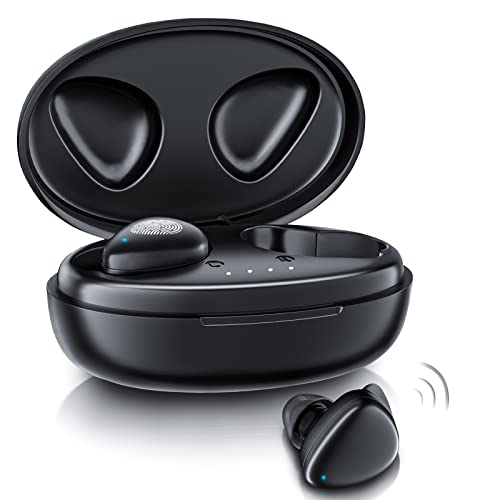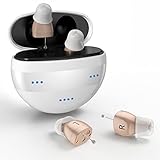Top 10 In Ear Hearing Aids
What Are In Ear Hearing Aids?
In-ear hearing aids, as the name suggests, are devices that fit directly in your ear canal and amplify sound. They’re small, discreet, and come in various shapes and sizes to fit different ears comfortably. These hearing aids work by capturing sounds through a microphone and converting them into electrical signals that are then amplified by a small computer chip inside the device. These amplified signals are transmitted through a speaker or receiver back into your ear canal. There are two main types of in-ear hearing aids: completely-in-canal (CIC) and invisible-in-canal (IIC). CIC hearing aids sit deep within the ear canal while IICs sit even deeper, making them virtually invisible from the outside. In addition to being cosmetically appealing, there are other benefits to using in-ear hearing aids. Since they sit deep within the ear canal, they can provide natural sound quality without picking up unwanted background noise. In-ear hearing aids offer an excellent solution for individuals with mild to moderate levels of hearing loss who want a discreet option that is easy to use and provides high-quality sound amplification.How Do In Ear Hearing Aids Work?
In Ear Hearing Aids work by amplifying sounds and improving the clarity of speech for individuals with hearing loss. Each in ear hearing aid consists of three basic components: a microphone, an amplifier, and a speaker. The microphone receives sound from the environment and converts it into electrical signals. These signals are then sent to the amplifier which increases their amplitude or strength. The amplified signals are then converted back into acoustic sound waves by the speaker located inside the ear canal. Most modern In Ear Hearing Aids use digital signal processing technology to analyze incoming sounds and automatically adjust their settings for optimal performance in different environments. Users can further customize their experience using smartphone apps that allow them to control volume levels, switch between programs designed for specific environments (such as noisy restaurants or quiet offices), and even track changes in their hearing over time. In Ear Hearing Aids offer a discreet solution that addresses mild-to-moderate hearing loss while providing advanced features for improved comfort and functionality.The Different Types of In Ear Hearing Aids
In ear hearing aids come in different types, each with its unique features and benefits. The first type is the invisible-in-canal (IIC) hearing aid, which is virtually undetectable when worn. This device sits deep inside the ear canal and requires good dexterity to handle. The second type of in-ear hearing aid is the completely-in-canal (CIC) model. It’s also a small device that fits entirely in the ear canal. It’s custom-made to fit your ear shape and size perfectly, ensuring maximum comfort. Another type of in-ear hearing aid is the In-the-canal (ITC), slightly larger than CICs but still relatively discreet compared to other hearing aid types. They’re suitable for mild-to-moderate levels of hearing loss. Half-shell or full-shell models sit more visibly within the outer part of your ear while still being relatively discreet compared to behind-the-ear devices. There are extended wear disposable devices that can be worn continuously for several months before needing replacement. These last up to 4 months at a time and don’t require daily removal so you can sleep with them on without any issues. When choosing an in-ear hearing aid, it’s important to consider factors such as your level of hearing loss, lifestyle needs, budget constraints and personal preferences before making a decision on which one suits you bestFactors to Consider Before Buying In Ear Hearing Aids
Before purchasing in ear hearing aids, there are several factors that one must consider. Firstly, it’s essential to identify the level of hearing loss and consult with an audiologist for a proper diagnosis. This will help determine the type of in ear hearing aid suitable for the individual. Another factor to consider is the size and shape of the device as it should fit comfortably within your ear canal without causing discomfort or irritation. Additionally, battery life is also an important aspect as some devices require frequent replacement or recharging. Cost is another critical consideration when buying in ear hearing aids as they can be quite expensive. It’s crucial to set a budget beforehand and research different options available while keeping in mind that cheaper alternatives may not always provide adequate quality. Furthermore, features such as noise reduction technology, Bluetooth connectivity and compatibility with smartphones should also be taken into account before making a purchase decision. By considering these factors before investing in an in-ear hearing aid device, individuals can ensure they choose a product that meets their needs and provides improved clarity of sound without compromising comfort or affordability.Benefits of Using In Ear Hearing Aids
Using in ear hearing aids can bring numerous benefits to those who struggle with hearing loss. Firstly, they are discreet and easy to wear, making them ideal for individuals who want a more subtle solution compared to traditional hearing aids. In addition, in ear hearing aids can be customized to fit the unique shape of your ear canal, providing a comfortable and secure fit that won’t fall out or cause discomfort during use. Not only do they provide enhanced sound quality and clarity by amplifying sounds directly into the ear canal, but many models also come equipped with advanced features such as noise reduction technology and Bluetooth connectivity. Additionally, using in ear hearing aids can improve overall communication abilities and social interactions. By being able to hear conversations more clearly, individuals may feel more confident engaging with others in various settings such as work meetings or social gatherings. The benefits of using in ear hearing aids extend beyond just improved auditory function. They offer greater convenience and discretion while enhancing one’s ability to communicate effectively with others.The Pros and Cons of In Ear Hearing Aids
In ear hearing aids are gaining in popularity due to their discreet design and advanced technology. However, like any other product, they come with both advantages and disadvantages. The main advantage of in ear hearing aids is their size. They are small enough to fit comfortably inside the ear canal, making them virtually invisible from the outside. This makes them an ideal option for people who want a discreet solution that won’t affect their appearance. Another advantage of in ear hearing aids is that they provide a more natural sound experience than their larger counterparts. Since they sit directly inside the ear, they can pick up sounds more accurately and deliver them directly to the eardrum. On the downside, in ear hearing aids may not be suitable for certain types of hearing loss as some models have limited amplification capabilities. Additionally, because of their small size, battery life may be shorter compared to behind-the-ear models. There’s also a risk of developing infections if proper hygiene isn’t maintained while wearing in-ear devices since bacteria can thrive in warm and moist environments such as ears. Despite these drawbacks, many people find that the benefits outweigh any potential downsides when it comes to choosing In Ear Hearing Aids over other types available on the market todayTips For Setting Up Your In Ear Hearing Aids
Setting up your in ear hearing aids can be a bit tricky, but with the right guidance, it could be a breeze. Here are some useful tips for setting up your in ear hearing aids: Firstly, make sure you have clean hands before handling your hearing aids to avoid any damage or contamination. Always store them appropriately when not in use. Next, familiarize yourself with the controls and buttons of your device. Most modern-day devices come with different options like volume control, noise reduction settings and program modes that cater to specific environments. It’s important to ensure that the fit of your hearing aid is comfortable and snug inside your ear canal. If it feels loose or causes discomfort upon insertion or removal, visit an audiologist who can help adjust the fit accordingly. Don’t forget about changing batteries regularly as this will help maintain optimal performance levels of your device. It’s also essential to keep spare batteries on hand at all times. Take note of any feedback or buzzing sounds while using your hearing aids as it may indicate an issue such as wax buildup which can easily be resolved by cleaning the device carefully. By following these simple tips for setting up and maintaining your in ear hearing aid device properly, you’ll enjoy better sound quality and comfort for longer periods without having to worry about unexpected malfunctions!FAQs
FAQs or frequently asked questions are common inquiries that most consumers have before buying any product, including in-ear hearing aids. Here are some of the commonly asked questions about this device: How long do in-ear hearing aid batteries last? Battery life varies depending on the type and usage of your device. Some devices can last up to five days, while others may only last for a day or two. Can I wear in-ear hearing aids while sleeping? It is not recommended to wear in-ear hearing aids while sleeping as it may cause discomfort and damage to your ears. Are there waterproof models available for outdoor activities? Yes, some manufacturers offer waterproof models designed specifically for outdoor activities like swimming or surfing. However, it’s important to check with your audiologist if these types of devices are suitable for you. Do insurance companies cover the cost of in-ear hearing aids? Some health insurance policies cover a portion or all the cost of purchasing an in-ear hearing aid. It’s best to check with your provider first before making any purchase. Can I use one device for both ears? Most people would need two devices; one for each ear since having just one might cause issues with sound localization and balance Understanding more about how in-ear hearing aids work can help you make a better-informed decision when choosing which model suits you best.Conclusion
In ear hearing aids are an excellent solution for individuals with mild to moderate hearing loss. These devices are discreet, affordable and provide sound quality that is comparable to larger traditional hearing aids. When shopping for in ear hearing aids, it’s important to consider factors such as ease of use, battery life and connectivity options. By doing so, you can ensure that you choose a device that meets your specific needs and preferences. Remember to always seek the advice of a licensed audiologist when choosing a hearing aid. They will be able to recommend the best options based on your individual requirements. In Ear Hearing Aids Consumer Reports suggest that these devices offer exceptional value and versatility without compromising on performance or functionality. So why wait? Take advantage of this innovative technology today and experience better sound quality than ever before!I’m Ella Andrews, owner of the website https://bestconsumerstips.com/
I give you valuable information about good products to help you choose the best product.











